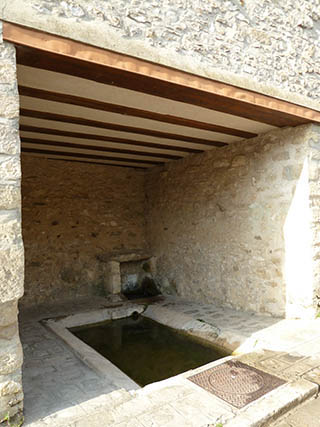Prochain point : lat="" lon=""

The wash house
Water, a day-to-day resource
A wash house on the River Montcient...
The importance of Gaillon-sur-Montcient's water resources can be seen from the fact that the village grew up on the slopes of the Montcient Valley. The existence of springs here meant that various facilities – wash houses, a pond, a drinking trough and fountains – could be built to take advantage of the water. Since the water table was not far below the surface, many houses could have their own wells.
This little wash house is unusual in that it is entirely located within the area of buildings belonging to the farm that overlooks it. A spring, protected by a stone slab, feeds a single tank with washing stones on three sides. Built in the late nineteenth century, the wash house was restored in 1959 and again in 1995.
...among many others
Much-used, the 'Presbytery Wash House', as it was usually referred to, was a communal wash house that was built in 1880, on the Rue de la Montcient, in the very centre of the village. It was fed by water from a plumbed spring. The Rouillis wash house on the Rue de Chaumières, too isolated and little-used, was destroyed in 1975 despite undergoing restoration work on several occasions. Near the crossroads where the Grande Rue and the Rue de la Douaye meet, there used to be another wash house fed by a spring, but it no longer exists; the spring in question flowed into the Douaye, a small tributary of the Montcient, before providing water for several private wash houses.
The 1821 Napoleonic land register shows that, opposite numbers 31 to 33 in the Grande Rue, there used to be a huge pond fed by a spring. A slight downward slope from the road made it possible for horses and cows to drink there. In May 1910, the municipality decided to build a concrete tank there, measuring 8 metres by 24 metres, and 1.8 metres deep. In 1973, it was drained and filled in after a child drowned in it.





